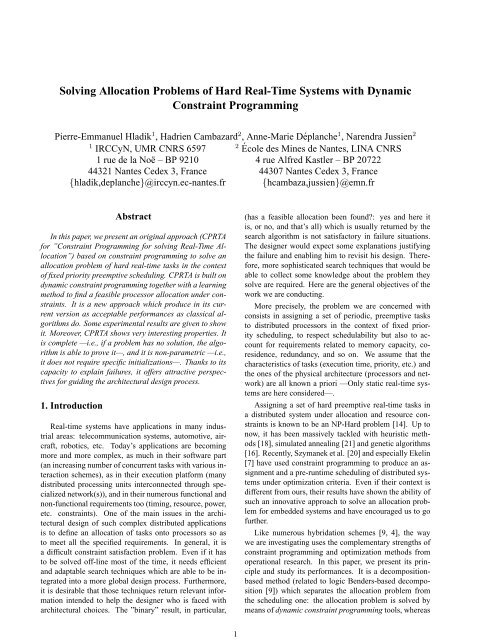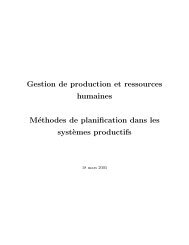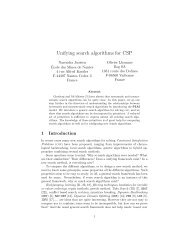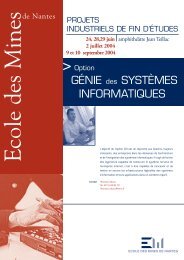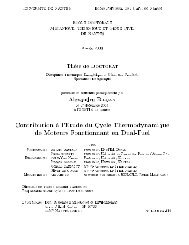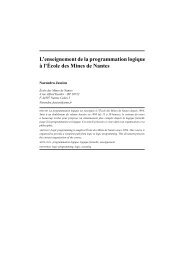Solving Allocation Problems of Hard Real-Time Systems with ...
Solving Allocation Problems of Hard Real-Time Systems with ...
Solving Allocation Problems of Hard Real-Time Systems with ...
Create successful ePaper yourself
Turn your PDF publications into a flip-book with our unique Google optimized e-Paper software.
<strong>Solving</strong> <strong>Allocation</strong> <strong>Problems</strong> <strong>of</strong> <strong>Hard</strong> <strong>Real</strong>-<strong>Time</strong> <strong>Systems</strong> <strong>with</strong> Dynamic<br />
Constraint Programming<br />
Pierre-Emmanuel Hladik 1 , Hadrien Cambazard 2 , Anne-Marie Déplanche 1 , Narendra Jussien 2<br />
1 IRCCyN, UMR CNRS 6597 2 École des Mines de Nantes, LINA CNRS<br />
1 rue de la Noë – BP 9210 4 rue Alfred Kastler – BP 20722<br />
44321 Nantes Cedex 3, France 44307 Nantes Cedex 3, France<br />
{hladik,deplanche}@irccyn.ec-nantes.fr {hcambaza,jussien}@emn.fr<br />
Abstract<br />
In this paper, we present an original approach (CPRTA<br />
for ”Constraint Programming for solving <strong>Real</strong>-<strong>Time</strong> <strong>Allocation</strong>”)<br />
based on constraint programming to solve an<br />
allocation problem <strong>of</strong> hard real-time tasks in the context<br />
<strong>of</strong> fixed priority preemptive scheduling. CPRTA is built on<br />
dynamic constraint programming together <strong>with</strong> a learning<br />
method to find a feasible processor allocation under constraints.<br />
It is a new approach which produce in its current<br />
version as acceptable performances as classical algorithms<br />
do. Some experimental results are given to show<br />
it. Moreover, CPRTA shows very interesting properties. It<br />
is complete —i.e., if a problem has no solution, the algorithm<br />
is able to prove it—, and it is non-parametric —i.e.,<br />
it does not require specific initializations—. Thanks to its<br />
capacity to explain failures, it <strong>of</strong>fers attractive perspectives<br />
for guiding the architectural design process.<br />
1. Introduction<br />
<strong>Real</strong>-time systems have applications in many industrial<br />
areas: telecommunication systems, automotive, aircraft,<br />
robotics, etc. Today’s applications are becoming<br />
more and more complex, as much in their s<strong>of</strong>tware part<br />
(an increasing number <strong>of</strong> concurrent tasks <strong>with</strong> various interaction<br />
schemes), as in their execution platform (many<br />
distributed processing units interconnected through specialized<br />
network(s)), and in their numerous functional and<br />
non-functional requirements too (timing, resource, power,<br />
etc. constraints). One <strong>of</strong> the main issues in the architectural<br />
design <strong>of</strong> such complex distributed applications<br />
is to define an allocation <strong>of</strong> tasks onto processors so as<br />
to meet all the specified requirements. In general, it is<br />
a difficult constraint satisfaction problem. Even if it has<br />
to be solved <strong>of</strong>f-line most <strong>of</strong> the time, it needs efficient<br />
and adaptable search techniques which are able to be integrated<br />
into a more global design process. Furthermore,<br />
it is desirable that those techniques return relevant information<br />
intended to help the designer who is faced <strong>with</strong><br />
architectural choices. The ”binary” result, in particular,<br />
(has a feasible allocation been found?: yes and here it<br />
is, or no, and that’s all) which is usually returned by the<br />
search algorithm is not satisfactory in failure situations.<br />
The designer would expect some explanations justifying<br />
the failure and enabling him to revisit his design. Therefore,<br />
more sophisticated search techniques that would be<br />
able to collect some knowledge about the problem they<br />
solve are required. Here are the general objectives <strong>of</strong> the<br />
work we are conducting.<br />
More precisely, the problem we are concerned <strong>with</strong><br />
consists in assigning a set <strong>of</strong> periodic, preemptive tasks<br />
to distributed processors in the context <strong>of</strong> fixed priority<br />
scheduling, to respect schedulability but also to account<br />
for requirements related to memory capacity, coresidence,<br />
redundancy, and so on. We assume that the<br />
characteristics <strong>of</strong> tasks (execution time, priority, etc.) and<br />
the ones <strong>of</strong> the physical architecture (processors and network)<br />
are all known a priori —Only static real-time systems<br />
are here considered—.<br />
Assigning a set <strong>of</strong> hard preemptive real-time tasks in<br />
a distributed system under allocation and resource constraints<br />
is known to be an NP-<strong>Hard</strong> problem [14]. Up to<br />
now, it has been massively tackled <strong>with</strong> heuristic methods<br />
[18], simulated annealing [21] and genetic algorithms<br />
[16]. Recently, Szymanek et al. [20] and especially Ekelin<br />
[7] have used constraint programming to produce an assignment<br />
and a pre-runtime scheduling <strong>of</strong> distributed systems<br />
under optimization criteria. Even if their context is<br />
different from ours, their results have shown the ability <strong>of</strong><br />
such an innovative approach to solve an allocation problem<br />
for embedded systems and have encouraged us to go<br />
further.<br />
Like numerous hybridation schemes [9, 4], the way<br />
we are investigating uses the complementary strengths <strong>of</strong><br />
constraint programming and optimization methods from<br />
operational research. In this paper, we present its principle<br />
and study its performances. It is a decompositionbased<br />
method (related to logic Benders-based decomposition<br />
[9]) which separates the allocation problem from<br />
the scheduling one: the allocation problem is solved by<br />
means <strong>of</strong> dynamic constraint programming tools, whereas<br />
1
the scheduling problem is treated <strong>with</strong> specific real-time<br />
schedulability analysis. The main idea is to ”learn”<br />
from the schedulability analysis to re-model the allocation<br />
problem so as to reduce the search space. In that sense, we<br />
can compare this approach to a form <strong>of</strong> learning from mistakes.<br />
Lastly we underline that a fundamental property <strong>of</strong><br />
this method is the completeness : when a problem has no<br />
solution, it is able to prove it (contrary to heuristic methods<br />
that are unable to decide).<br />
The remainder <strong>of</strong> this paper is organized as follows. In<br />
section 2, we describe the problem. Section 3 is dedicated<br />
to the description <strong>of</strong> the master- and sub-problems, and<br />
the relations between them. The logical Benders decomposition<br />
scheme is briefly introduced and the links <strong>with</strong><br />
our approach are put forward. In Section 4 the method is<br />
applied to a case study. Some experimental results are presented<br />
in Section 5. Section 6 shows how it is possible to<br />
set up a failure analysis able to aid the designer to review<br />
his plans. It is a first attempt that proves its feasibility and<br />
will need to go deeper. The paper ends <strong>with</strong> concluding<br />
remarks in Section 7.<br />
2 The problem description<br />
2.1 The real-time system architecture<br />
The hard real-time system we consider can be modeled<br />
by a s<strong>of</strong>tware architecture: the set <strong>of</strong> tasks, and a hardware<br />
architecture: the execution platform for the tasks, as<br />
represented in Fig. 1.<br />
p 1 p τ 2<br />
1<br />
m 1 m 2<br />
c 12 c 13 τ 5<br />
τ 2 τ 3 c 56<br />
bandwidth δ<br />
c 34<br />
c 24<br />
τ 6<br />
p 3<br />
p4<br />
τ 4<br />
m 3 m4<br />
τ i : (T i , C i , prio i , µ i )<br />
c ij : (d ij , prio ij )<br />
Figure 1. An example <strong>of</strong> hardware (left) and<br />
s<strong>of</strong>tware (right) architecture.<br />
By hardware architecture we mean a set P =<br />
{p 1 , . . . , p k , . . . , p m } <strong>of</strong> m processors <strong>with</strong> fixed memory<br />
capacity m k and identical processing speed. Each processor<br />
schedules tasks assigned to it <strong>with</strong> a fixed priority<br />
strategy. It is a simple rule : a static priority is given to<br />
each task and at run-time, the ready task <strong>with</strong> the highest<br />
priority is put in the running state, preempting eventually a<br />
lower priority task. Those processors are fully connected<br />
through a communication medium <strong>with</strong> a bandwidth δ. In<br />
this paper, we look at a communication medium called<br />
a CAN bus which is currently used in a wide spectrum<br />
<strong>of</strong> real-time embedded systems. However any other communication<br />
network could be considered as far as its timing<br />
behaviour (including its protocol rules) is predictable.<br />
Thus the first experiments we have conducted addressed a<br />
token ring network.<br />
CAN (Controller Area Network) [5] is both a protocol<br />
and physical network. CAN works as a broadcast bus<br />
meaning that all connected nodes will be able to read all<br />
messages sent on the bus. Each message has a unique<br />
identifier which is also used as the message priority. On<br />
each node waiting messages are queued. The bus makes<br />
sure that when a new message gets selected to transfer,<br />
the message <strong>with</strong> the highest priority, waiting on any<br />
connected node, will get transmitted first. When at least<br />
one bit <strong>of</strong> a message has started to be transfered it can’t<br />
get preempted even though higher priority messages<br />
arrive. As a result, the CAN’s behaviour will be seen<br />
subsequently as the one <strong>of</strong> a non preemptive fixed priority<br />
message scheduling.<br />
The s<strong>of</strong>tware architecture is modeled as a valued, oriented<br />
and acyclic graph (T , C). The set <strong>of</strong> nodes T =<br />
{τ 1 , ..., τ n } represents the tasks. A task in turn is a set<br />
<strong>of</strong> instructions which must be executed sequentially in the<br />
same processor. The set <strong>of</strong> edges C ⊆ T × T refers to the<br />
data sent between tasks.<br />
A task τ i is defined through timing characteristics and<br />
resource needs: its period T i (as a task is periodically<br />
activated ; the date <strong>of</strong> its first activation is free), its<br />
worst-case execution time <strong>with</strong>out preemption C i and its<br />
memory need µ i . A priority prio i is given to each task.<br />
Task τ j has priority over τ i if and only if prio i < prio j .<br />
Edges c ij = (τ i , τ j ) ∈ C are weighted <strong>with</strong> its tramission<br />
time C ij (the time it takes to transfer the message on<br />
the bus) together <strong>with</strong> a priority value prio ij (useful in<br />
the CAN context). Task priorities are assumed to be<br />
different. The same assumption is made on message<br />
priorities. In this model, we assume that communicating<br />
tasks have the same activation period. However, we don’t<br />
consider any precedence constraint between them : they<br />
are periodically activated in an independent way, and they<br />
read input data and write output data at the beginning and<br />
the end <strong>of</strong> their execution.<br />
The underlying communication model is inspired from<br />
OSEK-COM specifications [17]. OSEK-COM is an uniform<br />
communication environment for automotive control<br />
unit application s<strong>of</strong>tware. It defines common s<strong>of</strong>tware<br />
communication interface and behaviour for internal communications<br />
(<strong>with</strong>in an electronic control unit) and external<br />
ones (between networked vehicle nodes) which is independent<br />
<strong>of</strong> the communication protocol used. It is the<br />
following. Tasks that are located on the same processor<br />
communicate through local memory sharing. Such a local<br />
communication cost is assumed to be zero. On the<br />
other hand, when two communicating tasks are assigned<br />
to two distinct processors, the data exchange needs the<br />
transmission <strong>of</strong> a message on the network. Here we are<br />
interested <strong>with</strong> the periodic transmission mode <strong>of</strong> OSEK-<br />
COM. In this mode data production and message transmission<br />
aren’t synchronised : a producer task writes its<br />
output data into a local unqueued buffer from where a pe-
(a) tasks are allocated on the<br />
same processor<br />
c ij<br />
τ i τ j<br />
M ij<br />
τ i τj<br />
τ i τ j<br />
(b) tasks are allocated on<br />
different processors<br />
Figure 2. Depending <strong>of</strong> the task allocation,<br />
a message exists, or not.<br />
riodic protocol service reads it and sends it into a message.<br />
The building <strong>of</strong> protocol data units considered here<br />
is very simple : each data that has to be sent from a producer<br />
task τ i to a consumer task τ j in a distant way gives<br />
rise to its proper message M ij . Moreover in this paper,<br />
for a sake <strong>of</strong> simplicity, the asynchronous receiving mode<br />
is preferred. It means that the release <strong>of</strong> a consumer task<br />
τ j is strictly periodic and unrelated <strong>with</strong> the M ij message<br />
arrival : when a node receives a message from the bus, its<br />
protocol records its data into a local unqueued buffer from<br />
where it can be read by the task τ j . In [8] an extension <strong>of</strong><br />
this work to a synchronous receiving mode is proposed in<br />
which a message reception notification activates the consumer<br />
task.<br />
As a result, depending on the task allocation, an edge<br />
c ij <strong>of</strong> the s<strong>of</strong>tware architecture may give rise to two different<br />
equivalent schemes as illustrated in Fig. 2. In Fig. 2(b),<br />
M ij inherits its period T i from τ i and its priority prio ij<br />
from c ij .<br />
Therefore from a scheduling point <strong>of</strong> view, messages<br />
on the bus are very similar to tasks on a processor. Like for<br />
tasks, each message M ij is ”activated” every T i units <strong>of</strong><br />
time; its (bus) priority is prio ij ; and it has a transmission<br />
time C ij .<br />
2.2 The allocation problem<br />
An allocation is a mapping A : T → P such that:<br />
τ i ↦→ A(τ i ) = p k (1)<br />
The allocation problem consists in finding the mapping A<br />
which respects the whole set <strong>of</strong> constraints described in<br />
the immediate below.<br />
Timing constraints. They are expressed by the means<br />
<strong>of</strong> relative deadlines for the tasks. A timing constraint enforces<br />
the duration between the activation date <strong>of</strong> any instance<br />
<strong>of</strong> the task τ i and its completion time to be bounded<br />
by its relative deadline D i . Depending on the task allocation,<br />
such timing constraints may concern the instanciated<br />
messages too. For tasks as well as messages, their relative<br />
deadline is hereafter assumed equal to their activation<br />
period.<br />
Resource constraints. Three kinds <strong>of</strong> constraints are<br />
considered —precise units aren’t specified but obviously<br />
they have to be consistent <strong>with</strong> the given expressions—:<br />
• Memory capacity: The memory use <strong>of</strong> a processor<br />
p k cannot not exceed its capacity (m k ):<br />
∑<br />
∀k = 1..m, µ i ≤ m k (2)<br />
A(τ i)=p k<br />
• Utilization factor: The utilization factor <strong>of</strong> a processor<br />
cannot exceed its processing capacity. The following<br />
inequality is a necessary schedulability condition<br />
:<br />
∑ C i<br />
∀k = 1..m,<br />
≤ 1 (3)<br />
T i<br />
A(τ i)=p k<br />
• Network use: To avoid overload, the messages carried<br />
along the network per unit <strong>of</strong> time cannot exceed<br />
the network capacity:<br />
∑<br />
c ij = (τ i, τ j)<br />
A(τ i) ≠ A(τ j)<br />
C ij<br />
T i<br />
≤ 1 (4)<br />
<strong>Allocation</strong> constraints. <strong>Allocation</strong> constraints are due<br />
to the system architecture. We distinguish three kinds <strong>of</strong><br />
constraints.<br />
• Residence: a task may need a specific hardware or<br />
s<strong>of</strong>tware resource which is only available on specific<br />
processors (e.g. a task monitoring a sensor has to<br />
run on a processor connected to the input peripheral).<br />
This constraint is expressed as a couple (τ i , α) where<br />
τ i ∈ T is a task and α ⊆ P is the set <strong>of</strong> available host<br />
processors for the task. A given allocation A must<br />
respect:<br />
A(τ i ) ∈ α (5)<br />
• Co-residence: This constraint enforces several tasks<br />
to be assigned to the same processor (they share a<br />
common resource). Such a constraint is defined by a<br />
set <strong>of</strong> tasks β ⊆ T and any allocation A has to fulfil:<br />
∀(τ i , τ j ) ∈ β 2 , A(τ i ) = A(τ j ) (6)<br />
• Exclusion: Some tasks may be replicated for some<br />
fault-tolerance objectives and therefore cannot be assigned<br />
to the same processor. It corresponds to a set<br />
γ ⊆ T <strong>of</strong> tasks which cannot be placed together. An<br />
allocation A must satisfy:<br />
∀(τ i , τ j ) ∈ γ 2 , A(τ i ) ≠ A(τ j ) (7)<br />
An allocation A is said to be valid if it satisfies allocation<br />
and resource constraints. It is schedulable if it satisfies<br />
timing constraints. Finally, a solution to our problem<br />
is a valid and schedulable allocation <strong>of</strong> the tasks.
3 <strong>Solving</strong> the problem<br />
Constraint programming (CP) techniques have been<br />
widely used to solve a large range <strong>of</strong> combinatorial problems.<br />
They have proved quite effective in a wide range <strong>of</strong><br />
applications (from planning and scheduling to finance –<br />
portfolio optimization – through biology) thanks to main<br />
advantages: declarativity (the variables, domains, constraints<br />
description), genericity (it is not a problem dependent<br />
technique) and adaptability (to unexpected side<br />
constraints).<br />
A constraint satisfaction problem (CSP) consists <strong>of</strong> a<br />
set V <strong>of</strong> variables defined by a corresponding set D <strong>of</strong><br />
possible values (the so-called domain) and a set C <strong>of</strong> constraints.<br />
A solution to the problem is an assignment <strong>of</strong> a<br />
value in D to each variable in V such that all constraints<br />
are satisfied. This mechanism coupled <strong>with</strong> a backtracking<br />
scheme allows the search space to be explored in a<br />
complete way. For a deeper introduction to CP, we refer<br />
to [2].<br />
3.1 <strong>Solving</strong> strategy : Logic-based Benders decomposition<br />
in CP<br />
Due to space limitation, we only give the basic principles<br />
<strong>of</strong> this technique. Our approach is based on an extension<br />
<strong>of</strong> a Benders scheme. A Benders decomposition [3]<br />
is a solving strategy <strong>of</strong> linear problems that uses a partition<br />
<strong>of</strong> the problem among its variables: x, y. A master<br />
problem considers only x, whereas a subproblem tries to<br />
complete the assignment on y and produces a Benders cut<br />
added to the master. This cut is the central element <strong>of</strong> the<br />
technique, it is usually a linear constraint on x inferred by<br />
the dual <strong>of</strong> the subproblem. Benders decomposition can<br />
therefore be seen as a form <strong>of</strong> learning from mistakes.<br />
For a discrete satisfaction problem, the resolution <strong>of</strong><br />
the dual consists in computing the infeasibility pro<strong>of</strong> <strong>of</strong><br />
the subproblem (in this case, the dual is called an inference<br />
dual) and determining under what conditions the pro<strong>of</strong> remains<br />
valid to infer valid cuts. The Benders cut can be<br />
seen in this context as an explanation <strong>of</strong> failure which<br />
is learnt by the master. We refer here to a more general<br />
Benders scheme called logic Benders decomposition [9]<br />
where any kind <strong>of</strong> subproblems can be used as long as the<br />
inference dual <strong>of</strong> the subproblem can be solved.<br />
We propose an approach inspired from methods used to<br />
integrate constraint programming into a logic-based Benders<br />
decomposition [4]. The allocation and resource constraints<br />
are considered on one side, and schedulability on<br />
the other (see Fig. 3). The master problem solved <strong>with</strong><br />
constraint programming yields a valid allocation. The<br />
subproblem checks the schedulability <strong>of</strong> this allocation,<br />
eventually finds out why it is unschedulable and designs a<br />
set <strong>of</strong> constraints, named nogoods which rules out all the<br />
assignments which are unschedulable for the same reason.<br />
Learning<br />
nogoods<br />
unschedulable<br />
Master problem<br />
(constraint programming)<br />
Resource constraints<br />
<strong>Allocation</strong> constraints<br />
valid allocation<br />
Subproblem<br />
(schedulability analysis)<br />
Timing constraints<br />
schedulable allocation<br />
Figure 3. Logic-based Benders decomposition<br />
to solve an allocation problem<br />
3.2 Master problem<br />
As the master problem is solved using constraint programming<br />
techniques, we need first to translate our problem<br />
into CSP. The model is based on a redundant formulation<br />
using three kinds <strong>of</strong> variables: x, y, w.<br />
Let us first consider n integer-valued variables x which<br />
are decision variables and correspond to each task, representing<br />
the processor selected to process the task: ∀i ∈<br />
{1..n}, x i ∈ {1, . . . , m}. Then, boolean variables y<br />
indicate the presence <strong>of</strong> a task on a processor: ∀i ∈<br />
{1..n}, ∀p ∈ {1..m}, y ip ∈ {0, 1}. Finally, boolean<br />
variables w are introduced to express whether a pair <strong>of</strong><br />
tasks exchanging data are located on the same processor<br />
or not: ∀c ij = (τ i , τ j ) ∈ C, w ij ∈ {0, 1}. Integrity<br />
constraints are used to enforce the consistency <strong>of</strong> the redundant<br />
model.<br />
One <strong>of</strong> the main objectives <strong>of</strong> the master problem is to<br />
solve efficiently the assignment part. It handles two kinds<br />
<strong>of</strong> constraints: allocation and resource.<br />
• Residence: (cf. Eq. (5)) it consists <strong>of</strong> forbidden values<br />
for x. A constraint is added for each forbidden<br />
processor p <strong>of</strong> τ i : x i ≠ p<br />
• Co-residence: (cf. Eq. (6)) ∀(τ i , τ j ) ∈ β 2 , x i = x j<br />
• Exclusion: (cf. Eq. (7)) AllDifferent(x i |τ i ∈ γ). An<br />
AllDifferent constraint on a set V <strong>of</strong> variables ensures<br />
that all variables among V are different.<br />
• Memory capacity: (cf. Eq. (2)) ∀p ∈<br />
{1..m}, ∑ i∈{1..n} y ipµ i ≤ µ p<br />
• Utilization factor: (cf. Eq. (3)) Let lcm(T ) be the<br />
least common multiple <strong>of</strong> periods <strong>of</strong> the tasks —<br />
utilization factor and network use are reformulated<br />
<strong>with</strong> the lcm <strong>of</strong> task periods because our constraint<br />
solver cannot currently handle constraints <strong>with</strong> both<br />
real coefficients and integer variables—. The constraint<br />
can be written as follows:<br />
∀p ∈ {1..m},<br />
∑<br />
i∈{1..n}<br />
y ip lcm(T )C i<br />
T i<br />
≤ lcm(T )
• Network use: (cf. Eq. (4)) The network capacity is<br />
bound by δ. Therefore, the size <strong>of</strong> the set <strong>of</strong> messages<br />
carried on the network cannot exceed this limit:<br />
∑ w ij lcm(T )C ij<br />
≤ lcm(T )<br />
T i<br />
i∈{1..n}j∈{1..n}<br />
τ 1<br />
τ 1<br />
τ 2<br />
τ 2<br />
τ 3<br />
τ 3<br />
τ 4<br />
Deadline miss<br />
τ 4<br />
Deadline miss<br />
3.3 Subproblem<br />
The subproblem we consider here is to check whether a<br />
valid solution produced by the master problem is schedulable<br />
or not. A widely chosen approach for the schedulability<br />
analysis <strong>of</strong> a task set S is based on the following<br />
necessary and sufficient condition [15] : S is schedulable<br />
if and only if, for each task <strong>of</strong> S, its worst-case response<br />
time is less or equal to its relative deadline. Thus the subproblem<br />
solving leads us to compute worst-case response<br />
times for tasks on processors and for messages on the bus.<br />
According to the features <strong>of</strong> the considered task and message<br />
models, as well as the processor and bus scheduling<br />
algorithms, a ”classical” computation can be used and its<br />
main results are given in the immediate following.<br />
Task worst-case response time. For independent and<br />
periodic tasks <strong>with</strong> a preemptive fixed priority scheduling<br />
algorithm, it has been proven that the worst execution scenario<br />
for a task τ i happens when it is released simultaneously<br />
<strong>with</strong> all the tasks which have a priority higher than<br />
prio i . When D i is (less or) equal to T i , the worst-case<br />
response time for τ i is given by [15]:<br />
R i = C i +<br />
∑ ⌈ ⌉<br />
Ri<br />
C j (8)<br />
T j<br />
τ j∈hp i(A)<br />
where hp i (A) is the set <strong>of</strong> tasks <strong>with</strong> a priority higher than<br />
prio i and located on the processor A(τ i ) for a given allocation<br />
A, and ⌈x⌉ calculates the smallest integer ≥ x. The<br />
summation gives us the number <strong>of</strong> times tasks <strong>with</strong> higher<br />
priority will execute before τ i has completed. The worstcase<br />
response time R i can be easily solved by looking for<br />
the fix-point <strong>of</strong> Eq. (8) in an iterative way.<br />
Message worst-case response time. As mentioned earlier,<br />
message scheduling on the CAN bus can be viewed as<br />
a non-preemptive fixed priority scheduling strategy. Thus<br />
when doing a worst-case response time equation for a<br />
message, Eq. (8) has to be reused <strong>with</strong> some modifications.<br />
First it has to be changed so that a message only<br />
can be preempted during its first transmitted bit instead <strong>of</strong><br />
its whole execution time. Second a blocking time, i.e. the<br />
largest time the message might be blocked by a lower priority<br />
message, must be added. The resulting worst-case<br />
response time equation for the CAN message M ij is [22]:<br />
<strong>with</strong><br />
L ij =<br />
∑<br />
M ′ ∈hp ij(A)<br />
R ij = C ij + L ij (9)<br />
⌈ ⌉<br />
Lij + τ bit<br />
C ′ + max<br />
M ′ ∈lp {C′ −τ bit }<br />
ij(A)<br />
T ′<br />
(10)<br />
Figure 4. Illustration <strong>of</strong> a schedulability<br />
analysis. The task τ 4 does not meet its<br />
deadline. The subset {τ 1 , τ 2 , τ 4 } is identified<br />
to explain the unschedulability <strong>of</strong> the system.<br />
where hp ij (A) (respectively lp ij (A)) is the set <strong>of</strong> messages<br />
derived from the allocation A <strong>with</strong> a priority higher<br />
(respectively lower) than prio ij ; τ bit is the transmission<br />
time for one bit (τ bit is in relation <strong>with</strong> the bus bandwidth<br />
δ, τ bit = 1/δ) ; C ′ is the worst-case transmission time for<br />
the message M ′ .<br />
Here as well the computation <strong>of</strong> Eq. (10) can be solved<br />
iteratively.<br />
3.4 Cooperation between master and subproblem(s)<br />
We now consider a valid allocation (as the one the constraint<br />
programming solver may propose) in which some<br />
tasks are not schedulable. Our purpose is to explain why<br />
this allocation is unschedulable, and to translate this into<br />
a new constraint for the master problem.<br />
Tasks. The explanation for the unschedulability <strong>of</strong> a<br />
task τ i is the presence <strong>of</strong> tasks <strong>with</strong> higher priority on the<br />
same processor that interfere <strong>with</strong> τ i . For any other allocation<br />
<strong>with</strong> τ i and hp i (A) on the same processor, it is sure<br />
that τ i will still be detected unschedulable. Therefore, the<br />
master problem must be constrained so that all solutions<br />
where τ i and hp i (A) are together are not considered any<br />
further. This constraint corresponds to a NotAllEqual on<br />
x —A NotAllEqual on a set V <strong>of</strong> variables ensures that at<br />
least two variables among V take distinct values—:<br />
NotAllEqual (x j |τ j ∈ S i (A) = hp i (A) ∪ {τ i })<br />
It is worth noticing that this constraint could be expressed<br />
as a linear combination <strong>of</strong> variables y. However,<br />
NotAllEqual(x 1 ,x 3 ,x 4 ) excludes the solutions that contain<br />
the tasks τ 1 , τ 3 , τ 4 gathered on any processor.<br />
It is easy to see that this constraint is not totally relevant.<br />
For example, in Fig. 4, τ 4 that shares a processor<br />
<strong>with</strong> τ 1 ,τ 2 and τ 3 misses its deadline. Actually the set<br />
S 4 (A) = {τ 1 , τ 2 , τ 3 , τ 4 } explains the unschedulability but<br />
it is not minimal in the sense that if we remove one task<br />
from it, the set is still unschedulable. Here, the set S 4 (A) ′<br />
= {τ 1 , τ 2 , τ 4 } is sufficient to justify the unschedulability.<br />
In order to derive more precise explanations (to achieve<br />
a more relevant learning), a conflict detection algorithm,
namely QuickXplain [10] (see algorithm 1), has been used<br />
to determine a minimal (w.r.t. inclusion) set <strong>of</strong> involved<br />
tasks S i (A) ′ . A new function is defined, R i (X), as the<br />
worst-case response time <strong>of</strong> τ i as if it was scheduled <strong>with</strong><br />
those tasks belonging to the set X that have priority over<br />
it:<br />
∑<br />
⌈ ⌉<br />
Ri (X)<br />
R i (X) = C i +<br />
C j (11)<br />
τ j∈hp i(A)∩X<br />
Algorithm 1 Minimal task set<br />
QUICKXPLAINTASK(τ i , A, D i )<br />
X := ∅<br />
σ 1 , ..., σ #hpi(A) {an enumeration <strong>of</strong> hp i (A). The enumeration<br />
order <strong>of</strong> hp i (A) may have an effect on the<br />
content <strong>of</strong> the returned minimal task set}<br />
while R i (X) ≤ D i do<br />
k := 0<br />
Y := X<br />
while R i (Y ) ≤ D i k < #hp i (A) do<br />
k := k + 1<br />
Y := Y ∪ {σ k } {according to the enumeration<br />
order}<br />
end while<br />
X := X ∪ {σ k }<br />
end while<br />
return X ∪ {τ i }<br />
Messages. The reasoning is quite similar. If a message<br />
M ij is found unschedulable, it is because <strong>of</strong> the messages<br />
in hp ij (A) and the longest message in lp ij (A). We denote<br />
M ij (A) their union together <strong>with</strong> {M ij }. The translation<br />
<strong>of</strong> this information in term <strong>of</strong> constraint yields to:<br />
∑<br />
w ab < #M ij (A)<br />
M ab ∈M ij(A)<br />
where #X stands for the cardinality <strong>of</strong> X.<br />
It is equivalent to a NotAllEqual constraint on a set <strong>of</strong><br />
messages since to be met it requires that at least one message<br />
<strong>of</strong> M ij (A) ”disappear” (w ab = 0).<br />
Like for tasks, so as to reduce the set <strong>of</strong> involved<br />
messages, QUICKXPLAIN has been implemented, using<br />
a similar adaptation <strong>of</strong> Eq. (9) and (10). It returns a minimal<br />
set <strong>of</strong> messages M ij (A) ′ .<br />
Integration <strong>of</strong> nogoods in constraint programming<br />
solver. Dynamic integration <strong>of</strong> nogoods at any step <strong>of</strong><br />
the search performed by the MAC (Maintaining arc consistency)<br />
algorithm <strong>of</strong> the constraint solver is based on the<br />
use <strong>of</strong> explanations. Explanations consist <strong>of</strong> a set <strong>of</strong> constraints<br />
and record enough information to justify any decision<br />
<strong>of</strong> the solver such as a reduction <strong>of</strong> domain or a<br />
contradiction. Dynamic addition/retraction <strong>of</strong> constraints<br />
are possible when explanations are maintained [12].<br />
For example, the addition <strong>of</strong> a constraint at a leaf <strong>of</strong><br />
the tree search will not lead to a standard backtracking<br />
T j<br />
from that leaf (which could be very inefficient as a wrong<br />
choice may exist at the beginning <strong>of</strong> the search because<br />
the constraint was not known at that time). Instead, the<br />
solver will jump (MAC-CBJ for conflict directed backjumping)<br />
to a node appearing in the explanation and therefore<br />
responsible for the contradiction raised by the new<br />
constraint. More complex and more efficient techniques<br />
such as MAC-DBT (for dynamic backtracking) exist to<br />
perform intelligent repair <strong>of</strong> the solution after the addition<br />
or retraction <strong>of</strong> a constraint.<br />
4 Applying the method to an example<br />
An example to illustrate the theory is developed hereafter.<br />
It will show how the cooperation between masterand<br />
sub-problems is performed. Table 1 shows the characteristics<br />
<strong>of</strong> the considered hardware architecture (<strong>with</strong><br />
4 processors) and Table 2 those <strong>of</strong> the s<strong>of</strong>tware architecture<br />
(<strong>with</strong> 20 tasks). The entry ”x, y → j” for the task τ i<br />
indicates an edge c ij <strong>with</strong> C ij = x and prio ij = y.<br />
p i p 0 p 1 p 2 p 3<br />
m i 102001 280295 360241 41617<br />
Table 1. Processor characteristics<br />
τ i T i C i µ i prio i Message<br />
τ 0 36000 2190 21243 1 600,1 → 13<br />
τ 1 2000 563 5855 6 500,3 → 8<br />
τ 2 3000 207 2152 15 600,7 → 7<br />
τ 3 8000 2187 21213 3<br />
τ 4 72000 17690 168055 7 300,4 → 9<br />
τ 5 4000 667 6670 8 800,5 → 19<br />
τ 6 12000 3662 36253 14<br />
τ 7 3000 269 2743 16<br />
τ 8 2000 231 2263 12 100,6 → 18<br />
τ 9 72000 6161 59761 9<br />
τ 10 12000 846 8206 4 200,2 → 15<br />
τ 11 36000 5836 60694 20<br />
τ 12 9000 2103 20399 10<br />
τ 13 36000 5535 54243 13<br />
τ 14 18000 3905 41002 18<br />
τ 15 12000 1412 14402 5<br />
τ 16 6000 1416 14301 17 700,8 → 17<br />
τ 17 6000 752 7369 19<br />
τ 18 2000 538 5487 11<br />
τ 19 4000 1281 12425 2<br />
Table 2. Task and message characteristics<br />
The problem is constrained by :<br />
• residence constraints:<br />
– CC 1 : τ 0 must be allocated to p 0 or p 1 or p 2 .<br />
– CC 2 : τ 16 must be allocated to p 1 or p 2 .<br />
– CC 3 : τ 17 must be allocated to p 0 or p 3 .
• co-residence constraint:<br />
– CC 4 : τ 7 , τ 17 and τ 19 must be on the same processor.<br />
• exclusion constraints:<br />
– CC 5 : τ 3 , τ 11 and τ 12 must be on different processors.<br />
To start the resolution process, the solver for the master<br />
problem finds a valid solution in accordance <strong>with</strong> CC 1 ,<br />
CC 2 , CC 3 , CC 4 and CC 5 . How the constraint programming<br />
solver finds such a solution is here out <strong>of</strong> our purpose.<br />
The valid solution it returns is:<br />
• processor p 0 : τ 2 , τ 5 , τ 7 , τ 8 , τ 9 , τ 17 , τ 19 .<br />
• processor p 1 : τ 4 , τ 6 , τ 12 , τ 13 .<br />
• processor p 2 : τ 0 , τ 11 , τ 14 , τ 15 , τ 16 .<br />
• processor p 3 : τ 1 , τ 3 , τ 10 , τ 18 .<br />
One deduces that messages are M 0,13 , M 1,8 , M 4,9 , M 8,18 ,<br />
M 10,15 , and M 16,17 .<br />
It is easy to check it is a valid solution by considering<br />
allocation and resource constraints:<br />
• µ 2 +µ 5 +µ 7 +µ 8 +µ 9 +µ 17 +µ 19 = 93383 ≤ m 0 ;<br />
• µ 4 + µ 6 + µ 12 + µ 13 = 278950 ≤ m 1 ;<br />
• µ 0 + µ 11 + µ 14 + µ 15 + µ 16 = 151642 ≤ m 2 ;<br />
• µ 1 + µ 3 + µ 10 + µ 18 = 40761 ≤ m 3 ;<br />
• C2<br />
T 2<br />
+ C5<br />
T 5<br />
+ C7<br />
T 7<br />
+ C8<br />
T 8<br />
+ C9<br />
T 9<br />
+ C17<br />
T 17<br />
+ C19<br />
T 19<br />
= 0.972 ≤ 1;<br />
• C4<br />
T 4<br />
+ C6<br />
T 6<br />
+ C12<br />
T 12<br />
+ C13<br />
T 13<br />
= 0.938 ≤ 1;<br />
• C0<br />
T 0<br />
+ C11<br />
T 11<br />
+ C14<br />
T 14<br />
+ C15<br />
T 15<br />
+ C16<br />
T 16<br />
= 0.794 ≤ 1;<br />
• C1<br />
T 1<br />
+ C3<br />
T 3<br />
+ C10<br />
T 10<br />
+ C18<br />
T 18<br />
= 0.894 ≤ 1.<br />
• C0,13<br />
T 0<br />
+ C1,8<br />
T 1<br />
+ C4,9<br />
T 4<br />
+ C8,18<br />
T 8<br />
+ C10,15<br />
T 10<br />
+ C16,17<br />
T 16<br />
=<br />
0.454 ≤ 1.<br />
The subproblem checks now the schedulability <strong>of</strong> the<br />
valid solution. The schedulability analysis proceeds in<br />
three steps.<br />
First step: analysing the schedulability <strong>of</strong> tasks. The<br />
worst-case response time for each task is obtained by application<br />
<strong>of</strong> Eq. (8) and it is compared <strong>with</strong> its relative<br />
deadline. Here τ 5 , τ 12 , τ 16 and τ 19 are found unschedulable.<br />
Second step: analysing the schedulability <strong>of</strong> messages.<br />
The worst-case response time for each message is obtained<br />
by application <strong>of</strong> Eq. (9) and Eq. (10) and it is<br />
compared <strong>with</strong> its relative deadline. Here M 1,8 is found<br />
unschedulable.<br />
Third step: explaining why this allocation is not<br />
schedulable. The unschedulability <strong>of</strong> τ 5 is due to the interference<br />
<strong>of</strong> higher priority tasks on the same processor:<br />
hp 5 = {τ 2 , τ 7 , τ 8 , τ 9 , τ 17 }. By applying QUICKXPLAIN-<br />
TASK (see algorithm 1) <strong>with</strong> hp 5 ordered by increasing<br />
index, we find S 5 (A) ′ = {τ 5 , τ 9 } as minimal set. Consequently,<br />
the explanation <strong>of</strong> the unschedulability is translated<br />
into the new constraint:<br />
CC 6 : NotAllEqual{x 5 , x 9 }<br />
In the same way, by applying QUICKXPLAINTASK:<br />
• for τ 12 : CC 7 : NotAllEqual{x 6 , x 12 , x 13 },<br />
• for τ 16 : CC 8 : NotAllEqual{x 11 , x 16 },<br />
• for τ 19 : CC 9 : NotAllEqual{x 9 , x 19 }<br />
For M 1,8 , we have:<br />
M 1,8 (A) = {M 0,13 , M 1,8 , M 4,9 , M 8,18 , M 16,17 }.<br />
QUICKXPLAIN returns {M 0,13 , M 1,8 , M 4,9 , M 16,17 } as<br />
M 1,8 (A) ′ the minimal set. An other constraint is created:<br />
CC 10 : w 0,13 + w 1,8 + w 4,9 + w 16,17 < 4<br />
These new constraints CC 6 , CC 7 , CC 8 , CC 9 and<br />
CC 10 are added to the master problem. They define a<br />
new problem for which it has to search for a valid solution<br />
and so on.<br />
After 20 iterations between the master problem and the<br />
subproblem, this allocation problem is proven <strong>with</strong>out solution.<br />
This results from 78 constraints learnt all along<br />
the solving process. This example has been solved using<br />
ŒDIPE (see Section 5). On a computer <strong>with</strong> a G4 processor<br />
(800MHz), its computing time was 10.3 seconds.<br />
5 Experimental results<br />
We have developed a dedicated tool named ŒDIPE [6]<br />
that implements our solving approach (CPRTA). It is<br />
based on the CHOCO [13] constraint programming system<br />
and PALM [11], an explanation-based constraint programming<br />
system.<br />
For the allocation problem, no specific benchmarks are<br />
available as a point <strong>of</strong> reference in the real-time community.<br />
Experiments are usually done on didactic examples<br />
[21, 1] or randomly generated configurations [18, 16]. We<br />
opted for this last solution. Our generator takes several<br />
parameters into account:<br />
• n, m, mes: the number <strong>of</strong> tasks, processors (experiments<br />
have been done on fixed sizes: n = 40 and<br />
m = 7) and edges;<br />
• % global : the global utilization factor <strong>of</strong> processors;<br />
• % mem : the memory over-capacity, i.e. the amount<br />
<strong>of</strong> additionnal memory available on processors <strong>with</strong><br />
respect to the memory needs <strong>of</strong> all tasks;
Mem. % mem Alloc. % res % co−res % exc Sched. % global Mes. mes/n % msize<br />
1 60 1 0 0 0 1 40 1 0 0<br />
2 30 2 15 15 15 2 60 2 0.5 70<br />
3 10 3 33 33 33 3 90 3 0.875 150<br />
Table 3. Details on difficulty classes<br />
• % res : the percentage <strong>of</strong> tasks included in residence<br />
constraints;<br />
• % co−res : the percentage <strong>of</strong> tasks included in coresidence<br />
constraints;<br />
• % exc : the percentage <strong>of</strong> tasks included in exclusion<br />
constraints;<br />
• % msize : the size <strong>of</strong> a data is evaluated as a percentage<br />
<strong>of</strong> the period <strong>of</strong> the tasks exchanging it.<br />
Task periods and priorities are randomly generated.<br />
Worst-case execution times are initially randomly chosen<br />
and evaluated again so as: ∑ n<br />
i=1 C i/T i = m% global .<br />
The memory need <strong>of</strong> a task is proportional to its<br />
worst-case execution time. Memory<br />
∑<br />
capacities are randomly<br />
generated while satisfying: m<br />
k=1 m k = (1 +<br />
% mem ) ∑ n<br />
i=1 µ i. For a sake <strong>of</strong> simplicity, only linear data<br />
communications between tasks are considered and the priority<br />
<strong>of</strong> an edge is inherited from the task producing it.<br />
The number <strong>of</strong> tasks involved in allocation constraints<br />
is given by the parameters % res , % co−res , % exc . Tasks<br />
are randomly chosen and their number (involved in coresidence<br />
and exclusion constraints) can be set through<br />
specific levels. Several classes <strong>of</strong> problems have been defined<br />
depending on the difficulty <strong>of</strong> both allocation and<br />
schedulability problems. The difficulty <strong>of</strong> schedulability<br />
is evaluated using the global utilization factor % global<br />
which varies from 40 to 90 %. <strong>Allocation</strong> difficulty<br />
is based on the number <strong>of</strong> tasks included in residence,<br />
co-residence and exclusion constraints (% res , % co−res ,<br />
% exc ). Moreover, the memory over-capacity, % mem has<br />
a significant impact (a very low capacity can lead to solve<br />
a packing problem, sometimes very difficult). The presence<br />
<strong>of</strong> data exchanges impacts on both problems and the<br />
difficulty has been characterized by the ratios mes/n and<br />
% msize . % msize expresses the impact <strong>of</strong> data exchanges<br />
on schedulability analysis by linking periods and message<br />
sizes.<br />
Table 3 describes the parameters <strong>of</strong> each basic difficulty<br />
class. By combining them, categories <strong>of</strong> problems<br />
can be specified. For instance, a W-X-Y-Z category corresponds<br />
to problems <strong>with</strong> a memory difficulty in class W,<br />
an allocation difficulty in class X, a schedulability difficulty<br />
in class Y and a network difficulty in class Z.<br />
5.1 Results<br />
Table 4 summarizes some <strong>of</strong> the results <strong>of</strong> experiments<br />
<strong>with</strong> CPRTA. We do not give the results for all the intermediate<br />
classes <strong>of</strong> problems (like 1-1-1-1, 2-1-1-1, etc.)<br />
because they are easily solved and they don not exhibit<br />
a specific behaviour. % RES gives the number <strong>of</strong> problem<br />
instances successfully solved (a schedulable solution<br />
has been found or it has been proven that none exists)<br />
<strong>with</strong>in the time limit <strong>of</strong> 10 minutes per instance. % VAL<br />
gives the percentage <strong>of</strong> schedulable solutions found (thus<br />
% RES − % VAL gives the percentage <strong>of</strong> inconsistent problems).<br />
ITER is the number <strong>of</strong> iterations between the master<br />
problem and the subproblem. CPU is the mean computation<br />
time in seconds. NOG is the number <strong>of</strong> nogoods<br />
inferred from the subproblem. The data are obtained in<br />
average (on instances solved <strong>with</strong>in the required time) on<br />
100 instances (40 tasks, 7 processors) per class <strong>of</strong> difficulty<br />
<strong>with</strong> a Pentium 4 (3 GHz).<br />
First, by examining the CPU column, we notice that<br />
CPRTA still remains very efficient in spite <strong>of</strong> its seeming<br />
complexity. Moreover as measured by ITER and NOG,<br />
the cooperation between master and sub-problems is quite<br />
significant and the learning is <strong>of</strong> some importance.<br />
The lines 1 to 5 in Table 4 show results for high difficulty<br />
classes <strong>with</strong>out communications between tasks. The<br />
results in lines 1 to 3 are very good. They illustrate the<br />
basic ability <strong>of</strong> constraint programming to consider memory<br />
and allocation constraints. Lines 4 and 5 display some<br />
performances that are going down when the schedulability<br />
difficulty increases. Indeed, the schedulability constraints<br />
set is empty at the beginning <strong>of</strong> the search. Therefore, all<br />
the knowledge dealing <strong>with</strong> schedulability has to be learnt<br />
from the subproblem. Furthermore, learning is only effective<br />
when a valid solution is produced by the master<br />
problem solver and as a consequence it is not really integrated<br />
into the constraint programming algorithm. To improve<br />
CPRTA performances from this point <strong>of</strong> view, a new<br />
approach is now being developed that integrates schedulability<br />
analysis into the constraint programming algorithm<br />
so as not ”to delay” its taking into account —it is not a<br />
Benders decompostion, it is a new constraint defined from<br />
schedulability properties—.<br />
The lines 6 to 8 deal <strong>with</strong> allocation problems where<br />
tasks may communicate. Once more, one can notice<br />
that when data exchanges increase (and thus message exchanges<br />
on the bus too), the CPRTA performances decrease.<br />
Reasons are the same as those <strong>of</strong> task schedulability:<br />
the more the messages are on the bus, the more<br />
their scheduling becomes difficult. Moreover, we have observed<br />
that nogoods inferred from message unschedulability<br />
are usually ”weaker” (the search space cut is smaller)<br />
than the ones inferred from task unschedulability. Learning<br />
is then less efficient for this kind <strong>of</strong> problems. As for
tasks, we hope to improve CPRTA by integrating the network<br />
schedulability as a global constraint into the master<br />
problem.<br />
cat. % RES % VAL ITER CPU NOG<br />
1 2-2-2-1 100.0 56.0 13.5 1.6 95.2<br />
2 3-2-2-1 98.0 57.0 31.0 10.4 133.2<br />
3 2-3-2-1 99.0 19.0 6.6 1.4 43.5<br />
4 1-1-3-1 74.0 74.0 95.7 115.7 471.6<br />
5 2-2-3-1 67.0 12.0 8.3 33.2 59.7<br />
6 2-2-2-2 98.0 69.0 21.1 7.5 69.9<br />
7 1-2-2-3 66.0 43.0 188.3 70.5 110.7<br />
8 2-2-2-3 47.0 30.0 137.7 66.8 117.2<br />
Table 4. Average results on 100 instances<br />
randomly generated into classes <strong>of</strong> problems<br />
5.2 Comparison <strong>with</strong> simulated annealing<br />
As to get comparative performances for CPRTA, a simulated<br />
annealing (SA) algorithm, inspired from [21], has<br />
been implemented. In [21] the energy function takes into<br />
account residence, exclusion and memory constraints as<br />
well as task deadline constraints. To be consistent <strong>with</strong><br />
the CPRTA model, the schedulability <strong>of</strong> messages on the<br />
CAN bus and co-residence constraints have been integrated<br />
too. The implementation has been optimized so<br />
as to reduce computation times <strong>of</strong> this energy function.<br />
SA is a heuristic method. As a consequence, in our<br />
case, it can only conclude on problems <strong>with</strong> a solution.<br />
Therefore, in Table 5 only CPRTA results for such problems<br />
are compared to SA. As seen on Table 5, except<br />
for problems for which CPRTA must be improved (see<br />
Section 5.1), CPRTA produces as satisfactory results as<br />
SA does, but <strong>with</strong> better computation times. Introduction<br />
<strong>of</strong> schedulability as a constraint into the master problem<br />
should improve CPRTA, and certainly increases its efficiency<br />
in a significant manner. Moreover, it should be<br />
pointed out that even if CPRTA is sometimes less efficient<br />
than SA, CPRTA solves on average more problems than<br />
SA does if we take into account problems <strong>with</strong>out solution.<br />
SA CPRTA<br />
cat. % VAL CPU % VAL CPU<br />
2-2-2-1 56.0 4.7 56.0 2.4<br />
3-2-2-1 53.0 50.8 57.0 17.4<br />
2-3-2-1 16.0 35.5 19.0 4.1<br />
1-1-3-1 99.0 3.2 74.0 115.7<br />
2-2-3-1 20.0 113.9 12.0 60.82<br />
2-2-2-2 68.0 18.1 69.0 10.0<br />
1-2-2-3 64.0 52.0 43.0 27.4<br />
2-2-2-3 62.0 59.1 30.0 58.6<br />
Table 5. Comparison between CPRTA and<br />
SA<br />
6 Explanations<br />
In comparison <strong>with</strong> other search methods, using a constraint<br />
solver may help ”intrinsically” to answer some<br />
classical queries when a problem is proven <strong>with</strong>out solution<br />
such as: why does my problem have no solution<br />
? Usually, when the domain <strong>of</strong> a variable <strong>of</strong> a CSP becomes<br />
empty (no value exists that will respect all the constraints<br />
on that variable), basic constraint programming<br />
systems notify the user that there is no solution. Nevertheless,<br />
thanks to the versatility <strong>of</strong> the explanation-based constraint<br />
approach we use, those relevant constraints, which<br />
explain the failure, are made available in addition [11].<br />
Thus in the case <strong>of</strong> an allocation problem for which<br />
no solution has been found, we analyse the set <strong>of</strong> constraints<br />
that is returned to explain the problem inconsistency.<br />
There can be many reasons to explain inconsistency.<br />
At the design level, we would like to be able to<br />
incriminate high level characteristics <strong>of</strong> the system such<br />
as : allocation constraints, schedulability requirements <strong>of</strong><br />
tasks, processors or network limitation. However, two<br />
points <strong>of</strong> view, based on the s<strong>of</strong>tware or hardware architecture,<br />
can be adopted. We will first focus on the characteristics<br />
<strong>of</strong> the s<strong>of</strong>tware architecture by analysing how<br />
each task is ”responsible” for the failure. We will give<br />
there some insight on the way a critical task from the<br />
schedulability point <strong>of</strong> view can be identified. Each failure<br />
<strong>of</strong> the search process due to schedulability is analysed<br />
and transformed into a constraint criterion that encapsultates<br />
an accurate reason for this failure. The study <strong>of</strong> those<br />
criteria may lead to the guilty tasks. The rationale <strong>of</strong> this<br />
evaluation is based on the following remarks:<br />
• The more a task appears <strong>with</strong>in a nogood, the more<br />
this task has an impact on the schedulability inconsistency.<br />
• The level <strong>of</strong> propagation performed by a nogood (either<br />
NotAllEqual(x i ) or ∑ w ij < B), i.e its impact<br />
<strong>with</strong>in the pro<strong>of</strong> is strongly related to its size (the<br />
number <strong>of</strong> tasks it involves). ”Small” NotAllEqual<br />
have stronger impact.<br />
In its general form, a constraint (learnt from a nogood)<br />
is defined by NotAllEqual(x i ) or ∑ w ij < B (see Section<br />
3.4). We denote NAE the set <strong>of</strong> constraints in the<br />
NotAllEqual form and SUM the set <strong>of</strong> constraints in the<br />
second form. For a task τ i a constraint criterion C i is evaluated:<br />
C i =<br />
∑<br />
c ∈ NAE<br />
x i ∈ c<br />
1<br />
#c + ∑<br />
c ∈ SUM<br />
∃j, w ij ∈ c ∨ w ji ∈ c<br />
1<br />
#c<br />
This criterion considers the presence <strong>of</strong> a task in each constraint<br />
and its impact. Bigger C i is, bigger the impact <strong>of</strong><br />
τ i is on the inconsistency. By studying tasks <strong>with</strong> high C i<br />
and understanding why they have such an impact on the
inconsistency (e.g. low priority allocation, too large processor<br />
utilization), it is possible to change some requirements<br />
(e.g. by adapting priorities, or choosing a different<br />
version for a task <strong>with</strong> an other period) and so to obtain a<br />
solution for the problem.<br />
Table 6 gives C i obtained on the example <strong>of</strong> the Section<br />
4 <strong>with</strong> ŒDIPE [6]. Task τ 19 has the biggest C i . This<br />
task has a low priority together <strong>with</strong> a high processor utilization<br />
(C 19 /T 19 = 0.32). By just changing its priority to<br />
the highest one, and reusing CPRTA, we found a solution<br />
for this problem.<br />
Notice that this process consists in analysing the final<br />
set <strong>of</strong> constraints <strong>with</strong> a heuristic based on the information<br />
gathered during the search. This process can be generalized<br />
to memory and allocation constraints by the use <strong>of</strong> a<br />
specific search technique [19] even if explicit reasons for<br />
failure on memory or allocation are not kept in memory in<br />
our current approach (contrary to schedulability one).<br />
τ i C i τ i C i τ i C i τ i C i<br />
τ 19 6.33 τ 13 4.78 τ 2 3.22 τ 3 2.53<br />
τ 14 5.98 τ 9 3.95 τ 1 2.85 τ 16 2.25<br />
τ 11 5.98 τ 6 3.83 τ 10 2.77 τ 18 1.97<br />
τ 5 5.42 τ 7 3.45 τ 4 2.65 τ 8 1.73<br />
τ 12 5.42 τ 15 3.32 τ 17 2.55 τ 0 1.15<br />
Table 6. Constraint criterions computed on<br />
example<br />
7 Conclusion and future work<br />
In this paper, we present an original and complete approach<br />
(CPRTA) to solve a hard real-time allocation problem.<br />
We use a decomposition method which is built<br />
on a logic Benders decomposition scheme. The whole<br />
problem is split into a master problem handling allocation<br />
and resource constraints and a subproblem for timing<br />
constraints. A rich interaction between master and subproblems<br />
is performed <strong>with</strong> the computation <strong>of</strong> minimal<br />
sets <strong>of</strong> unschedulable tasks and messages. It implements<br />
a kind <strong>of</strong> learning technique in an effort to combine the<br />
various issues into a solution that satisfies all constraints.<br />
One important specificity <strong>of</strong> CPRTA is its completeness,<br />
i.e., if a problem has no solution, the search algorithm<br />
is able to prove it. Moreover it <strong>of</strong>fers good potential<br />
means for building an analysis able to give an aid to the<br />
user in case <strong>of</strong> failure.<br />
The results produced by our experiments encourage us<br />
to go a step further. Further works concern the inclusion<br />
<strong>of</strong> (task and message) schedulability analysis into the<br />
search process <strong>of</strong> the CP algorithms in the form <strong>of</strong> a global<br />
constraint. This should improve efficiency <strong>of</strong> CPRTA for<br />
hard-schedulability-constrained problems. Another interesting<br />
work deals <strong>with</strong> the explanation <strong>of</strong> failure. Our aim<br />
is to integrate into the design process an intelligent tool<br />
based on CPRTA ables to return pertinent explanations<br />
justifying the failure. We need to go deeper in that way<br />
and to try it out on some concrete cases.<br />
References<br />
[1] P. Altenbernd and H. Hansson. The slack method: A new<br />
method for static allocation <strong>of</strong> hard real-time tasks. <strong>Real</strong>-<br />
<strong>Time</strong> <strong>Systems</strong>, 15(2):103–130, 1998.<br />
[2] R. Barták. Constraint programming: In pursuit <strong>of</strong> the holy<br />
grail. In Proc. <strong>of</strong> the Week <strong>of</strong> Doctoral Students (WDS99),<br />
1999.<br />
[3] J. F. Benders. Partitioning procedures for solving mixedvariables<br />
programming problems. Numerische Mathematik,<br />
4:238–252, 1962.<br />
[4] T. Benoist, E. Gaudin, and B. Rottembourg. Constraint<br />
programming contribution to benders decomposition: a<br />
case study. Lecture notes in Computer Science, 2470:603–<br />
617, 2002.<br />
[5] Bosch. CAN Specification version 2.0, 1991.<br />
[6] H. Cambazard and P. Hladik. ŒDIPE. http://oedipe.rtss<strong>of</strong>tware.org/.<br />
[7] C. Ekelin. An Optimization Framework for Scheduling <strong>of</strong><br />
Embedded <strong>Real</strong>-<strong>Time</strong> <strong>Systems</strong>. PhD thesis, Chalmers University<br />
<strong>of</strong> Technology, 2004.<br />
[8] P.-E. Hladik and A.-M. Déplanche. Extension au réseau<br />
can des problèmes de placement. Technical Report 4, IR-<br />
CCyN, 2005.<br />
[9] J. N. Hooker and G. Ottoson. Logic-based benders decomposition.<br />
Mathematical Programming, 96:33–60, 2003.<br />
[10] U. Junker. Quickxplain: Conflict detection for arbitrary<br />
constraint propagation algorithms. In Proc. <strong>of</strong> IJCAI 01,<br />
2001.<br />
[11] N. Jussien. The versatility <strong>of</strong> using explanations <strong>with</strong>in<br />
constraint programming. Technical Report RR 03-04-<br />
INFO, École des Mines de Nantes, 2003.<br />
[12] N. Jussien, R. Debruyne, and P. Boizumault. Maintaining<br />
arc-consistency <strong>with</strong>in dynamic backtracking. In CP 2000,<br />
number 1894 in Lecture Notes in Computer Science, pages<br />
249–261, Singapore, Sept. 2000. Springer-Verlag.<br />
[13] CHOCO. http://choco.sourceforge.net/.<br />
[14] E. Lawler. Recent results in the theory <strong>of</strong> machine scheduling.<br />
Mathematical Programming: The State <strong>of</strong> the Art,<br />
1983.<br />
[15] J. P. Lehoczky. Fixed priority scheduling <strong>of</strong> periodic task<br />
sets <strong>with</strong> arbitrary deadlines. In proceedings <strong>of</strong> the 11th<br />
IEEE <strong>Real</strong>-<strong>Time</strong> <strong>Systems</strong> Symposium (RTSS 1990), pages<br />
201–209, 1990.<br />
[16] Y. Monnier, J.-P. Beauvais, and A.-M. Déplanche. A genetic<br />
algorithm for scheduling tasks in a real-time distributed<br />
system. In ECRTS’98, 1998.<br />
[17] OSEK Group. OSEK/VDX Communication version 3.0.2.<br />
[18] K. Ramamritham. <strong>Allocation</strong> and scheduling <strong>of</strong> complex<br />
periodic tasks. In Proc. <strong>of</strong> ICDCS 1990, 1990.<br />
[19] P. Refalo. Impact-based search strategies for constraint<br />
programming. In Proc. <strong>of</strong> CP 2004, 2004.<br />
[20] R. Szymanek, F. Gruian, and K. Kuchcinski. Digital systems<br />
design using constraint logic programming. In Proc.<br />
<strong>of</strong> PACLP 2000, 2000.<br />
[21] K. W. Tindell, A. Burns, and A. Wellings. Allocating hard<br />
real-time tasks: An np-hard problem made easy. <strong>Real</strong>-<br />
<strong>Time</strong> <strong>Systems</strong>, 4(2):145–165, 1992.<br />
[22] K. W. Tindell, H. Hansson, and A. J. Wellings. Analysis<br />
real-time communications: controller area network (can).<br />
In Proc. <strong>of</strong> RTSS 1994, pages 259–265, 1994.


